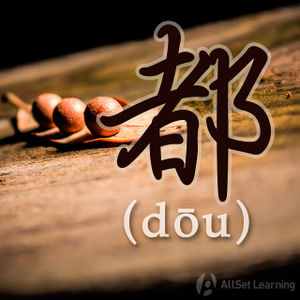Difference between revisions of "The "all" adverb "dou""
Wu.mengmeng (talk | contribs) |
Wu.mengmeng (talk | contribs) |
||
| Line 1: | Line 1: | ||
| + | {{Grammar Box}} | ||
The adverb 都 is used to express "all" in Chinese. In Chinese, it's more common to mark this than in English. If the subject is plural, 都 is often expected. | The adverb 都 is used to express "all" in Chinese. In Chinese, it's more common to mark this than in English. If the subject is plural, 都 is often expected. | ||
| Line 31: | Line 32: | ||
[[Category:A1 grammar points]] | [[Category:A1 grammar points]] | ||
| + | {{Basic Grammar|都|A1|都 + V / 都 + Adj|我们 <em>都 爱</em> 你 。|grammar point|ASG9YK09}} | ||
| + | {{Similar|"Ye" and "dou" together}} | ||
| + | {{Similar|The also adverb}} | ||
Revision as of 03:30, 13 June 2012
-
Level
-
Similar to
-
Used for
-
Keywords
The adverb 都 is used to express "all" in Chinese. In Chinese, it's more common to mark this than in English. If the subject is plural, 都 is often expected.
Structure
Subject + 都 + Verb + Object
Remember that 都 appears after the subject. A common mistake learners make is to put 都 at the beginning of the sentence (as "all" often appears there in English). This isn't good Chinese - make sure you put 都 after the subject. Some examples:
- 我们 都 是 德国人。
- 他们 都 踢足 球。
- 你们 都 学 中文 吗?



